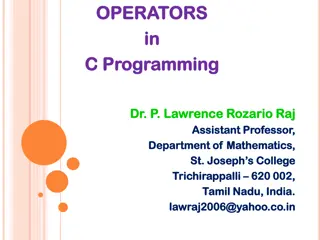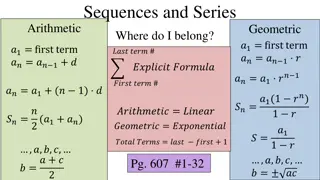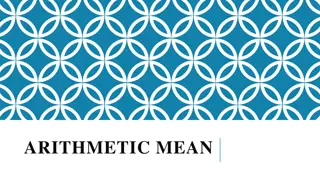Understanding Arithmetic Progressions in Mathematics
Explore the concept of arithmetic progressions (AP) in mathematics by understanding sequences, series, and how to identify and work with APs. Learn about common differences, nth terms, sum of terms, and practical applications of AP in daily life. Discover methods to verify if a given sequence is in AP and solve problems related to AP. Engage in activities to reinforce learning and develop problem-solving skills in mathematics.
Download Presentation

Please find below an Image/Link to download the presentation.
The content on the website is provided AS IS for your information and personal use only. It may not be sold, licensed, or shared on other websites without obtaining consent from the author. Download presentation by click this link. If you encounter any issues during the download, it is possible that the publisher has removed the file from their server.
E N D
Presentation Transcript
CLASS-X MATHEMATICS ARITHMETIC PROGRESSION
Learning Objectives Students will be able to 1. recall some patterns which occur in their day to day life. 2. know the condition when the pattern will be in arithmetic progression. 3. know various terms associated with AP, i.e 1stterm and common difference. 4. understand different types of AP, finite & infinite. 5. understand the formula to find nth term and sum of n terms of an AP. 6. apply the knowledge of finding nth term and sum of n terms of an AP in solving day to day life problems.
Sequence Sequence A sequence is a set of numbers written in a particular order Examples of sequence: 1, 3, 5, 7, 9, . . . . 1, 4, 9, 16, 25, . . . . 1, 1, 1, 1, 1, 1, . . . , 1, 3, 5, 9
Series Series A series is something we obtain from a sequence by adding all the terms together. For example, let us consider the sequence of numbers 1, 2, 3, 4, 5, 6, . . ., n . Then S1 = 1, as it is the sum of just the first term on its own. The sum of the first two terms is S2 = 1 + 2 = 3. Continuing, we get S3 = 1 + 2 + 3 = 6 , S4 = 1 + 2 + 3 + 4 = 10 ,
Arithmetic progressions Arithmetic progressions An arithmetic progression, or AP, is a sequence where each new term after the first is obtained by adding a constant d, called the common difference, to the preceding term. If the first term of the sequence is a then the arithmetic progression is a, a + d, a + 2d, a + 3d, . . . Where d is the common difference
To check that a given terms are in A.P. or not. 2, 6, 10, 14 . Here first term a =2, find differences in thenext terms a2-a1 = 6 2 =4 a3-a2 =10 6 =4 a4-a3 = 14 10 =4 Since the difference between the consecutive terms is same Hence the given terms are in A.P.
EXAMPLE 1: Find the value of k for which the given series is in A.P. 4, k 1 ,12 Solution : Given A.P.is4, k 1 , 12 .. If series is A.P. then the differenceswill be common. d1 =d1 a2 a1 =a3 a2 k 1 4 = 12 (k 1) k 5 = 12 k +1 k + k = 12 + 1 +5 2K=18 K=9
ACTIVITY ACTIVITY- -1 1 Objective: To verify that the given sequence is an arithmetic progression by paper cutting and pasting method. Materials required: coloured paper, pair of scissors, geometry box, fevicol, sketch pens, one squared paper
ACTIVITY ACTIVITY- -1(continued..) 1(continued..) Procedure : Take a given sequence of numbers say a1 , a2 , a3 . 2. Cut a rectangular strip from a colored paper of width k = 1 cm (say) and length a1 cm. 3. Repeat this procedure by cutting rectangular strips of the same width k = 1cm and lengths a2 , a3 , a4 , cm. 4. Take 1 cm squared paper and paste the rectangular strips adjacent to each other in order.
ACTIVITY ACTIVITY- -1(continued..) 1(continued..) Let the sequence be 1, 4, 7, 10, . Take strips of lengths 1 cm, 4 cm, 7 cm and 10 cm, all of the same width say 1 cm. Arrange the strips in order as shown in Fig 2(a). Observe that the adjoining strips have a common difference in heights. (In this example it is 3 cm.)
ACTIVITY ACTIVITY- -1(continued..) 1(continued..)
ACTIVITY ACTIVITY- -1(continued..) 1(continued..) Let another sequence be 1, 4, 6, 9, Take strips of lengths 1 cm, 4 cm, 6 cm and 9 cm all of the same width say 1 cm. Arrange them in an order as shown in Fig 2(b). Observe that in this case the adjoining strips do not have the same difference in heights.
ACTIVITY ACTIVITY- -1(continued..) 1(continued..)
Conclusion So, from the figures, it is observed that if the given sequence is an arithmetic progression, a ladder is formed in which the difference between the heights of adjoining steps is constant. If the sequence is not an arithmetic progression, a ladder is formed in which the difference between adjoining steps is not constant.
nth Term of an AP nth Term of an AP a, a + d, a + 2d, a + 3d, a + 4d, . . .is an AP. where a is the first term, and d is the common difference. If we wanted to write down the n-th term, we would have a + (n 1)d , ??= ? + ? 1 ?
Lets see an example EXAMPLE 1: Let a=2,d=2, n=12,find An An=a+(n-1)d =2+(12-1)2 =2+(11)2 =2+22 Therefore, An=24 Hence solved.
nth Term of an AP nth Term of an AP Example-2: Write down the first five terms of the AP with first term 8 and common difference 7. Ans: 8,15,22,29,36 Example-3: Write down the first five terms of the AP with first term 2 and common difference 5. Ans: 2, -3, -8,-13,-18
nth Term of an AP nth Term of an AP Example 4: What is the common difference of the AP 11, 1, 13, 25, . . . ? Ans: common difference = -1-11 =-13-(-1) =-12
nth Term of an AP nth Term of an AP Example-5: Find the 17th term of the arithmetic progression with first term 5 and common difference 2. Ans: Here a= 5 , d=2 ?17= 5 +17 1 2 = 5 + 32 = 37
The sum of an arithmetic series The sum of an arithmetic series Sometimes we want to add the terms of a sequence. Let us see the video https://youtu.be/S6F6jeVX-b8 What would we get if we wanted to add the first n terms of an arithmetic progression? We would get Sn = a + (a + d) + (a + 2d) + . . . + ( 2d) + ( d) + . This is now a series, as we have added together the n terms of a sequence. This is an arithmetic series, and we can find its sum by using a trick.
The sum of an arithmetic series The sum of an arithmetic series Let us write the series down again, but this time we shall write it down with the terms in reverse order. We get Sn = + ( d) + ( 2d) + . . . + (a + 2d) + (a + d) + a 2Sn = (a + ) + (a + ) + (a + ) + . . . + (a + ) + (a + ) + (a + ), 2Sn = n(a + )
The sum of an arithmetic series The sum of an arithmetic series Sn = n(a + ). = a + (n 1)d , Sn = n(a + ) Sn = n(a + a + (n 1)d) Sn= n(2a + (n 1)d).
The sum of an arithmetic series The sum of an arithmetic series Example -1: Find the sum of the first 50 terms of the sequence 1, 3, 5, 7, 9, . . . . Solution : This is an arithmetic progression, a = 1 , d = 2 , n = 50 . Sn = n(2a + (n 1)d) S50 = 50 (2 1 + (50 1) 2) = 25 (2 + 49 2) = 25 (2 + 98) = 2500
The sum of an arithmetic series The sum of an arithmetic series Example-2: Find the sum of the series 1 + 3 5 + 6 + 8 5 + . . . + 101 . Solution : Given a=1 , d= 3.5 - 1 = 2.5 and =101 we know = a + (n 1)d 101 = 1 + (n 1) 2 5 . 100 = (n 1) 2 5 40 = n 1 n = 41 So, Sn = n(a+ )= 41(1+101)=2091
The sum of an arithmetic series The sum of an arithmetic series Example -3: An arithmetic progression has 3 as its first term. Also, the sum of the first 8 terms is twice the sum of the first 5 terms. Find the common difference. Solution : Given a = 3. S8= 8 (6 + 7d), S5= 5 (6 + 4d) S8 = 2S5, we see that 8 (6 + 7d) = 2 5 (6 + 4d) 4 (6 + 7d) = 5 (6 + 4d) 24 + 28d = 30 + 20d 8d = 6 d = .
Example 4: Find number of terms of A.P. 100, 105, 110, 115,, 500 Solution : First term is a = 100 , an =500 Common difference is d = 105-100 =5 nth term is an = a +(n-1)d 500 = 100 +(n-1)5 500 -100 = 5(n 1) 400 = 5(n 1) 5(n 1) =400
5(n 1) =400 n 1 =400/5 n -1=80 n =80+1 n =81 Hence the no. of term is 81.
Example 5 . Find the sum of 30 terms of given A.P 12 , 20 , 28 , 36 Solution : Given A.P. is 12 , 20, 28 , 36 Its first term is a =12 Common difference is d = 20 12 =8 The sum to n terms of an arithmetic progression Sn = n/2 [ 2a + (n -1)d] = x 30 [ 2x 12 + (30-1)x 8] = 15 [ 24 + 29 x8]
= 15[24 +232] = 15 x246 =3690 THE SUM OF TERMS IS 3690
Summary In this chapter, you have studied the following points : An arithmetic progression (AP) is a list of numbers in which each term is obtained by adding a fixed number d to the preceding term, except the first term. The fixed number d is called the common difference. The general form of an AP is a, a + d, a + 2d, a + 3d, . . .
Summary A given list of numbers a1, a2, a3, . . . is an AP, if the differences a2 a1, a3 a2, a 4 a3, . . ., give the same value, i.e., if ak + 1 ak is the same for different values of k. In an AP with first term a and common difference d, the nth term (or the general term) is given by an = a + (n 1) d.
Summary The sum of the first n terms of an AP is given by : S n= n[2a+(n-1)d] If l is the last term of the finite AP, say the nth term, then the sum of all terms of the AP is given by : Sn = n(a+l)
MIND MAP Sum of first n positiveintegers Let sn= 1 + 2 + 3 + ... n a = 1, last term l = n How many 2-digit numbersare divisible by 3? sn=n(a+l)=n(1+n) 2 2-digit numbers divisible by 3 12, 15, 18, ... 99 a = 12, d = 3, an= 99 an= a + (n 1)d 99 = 12 + (n 1)3 2 or sn=n(n+l) 2 sn=n(a+l) 2 n 1 =87= 29 i.e., List of numbers in which each term is obtained by adding a fixed number to the precedingtermexceptthe firstterm. Fixednumberiscalledcommon difference. 3 n = 30 er Arithmetic Progression a, a+d, a+2d, a+3d, ... a+(n 1) d If a, b, c, are in AP, b =a + c Fixed number in arithmetic progression which provides the toandfrotermsbyadding/ subtracting from the present number. Can be positive or negative. 2 hTe b is arithmeticmean From beginning an = a+(n 1)d Here a firstterm a- First term d- common difference When first term of common differnceis given : ? ??= 2 {2? + (? 1)?} Whenfirst& last terms aregiven: d co m on di ? ??= 2 (? + ??)























